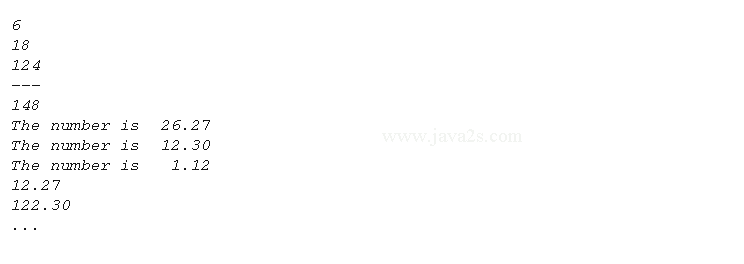Commonly Used Stream Manipulators - C++ Language Basics
C++ examples for Language Basics:Console
Introduction
| Manipulator | Action |
|---|---|
| setw(n) | Set the field width to n. |
| setprecision(n) | Set the floating-point precision to n places. |
| setfill('x') | Set the default leading fill character to x. |
| setiosflags(flags) | Set the format flags. |
| scientific | Set the output to display real numbers in scientific notation. |
| showbase | Display the base used for numbers. A leading 0 is displayed for octal numbers and a leading 0x for hexadecimal numbers. |
| showpoint | Always display six digits total. Fill with trailing zeros, if necessary. |
| showpos | Display all positive numbers with a leading + sign. |
| boolalpha | Display Boolean values as true and false rather than 1 and 0. |
| dec | Set the output for decimal display, which is the default. |
| endl | Output a newline character and display all characters in the buffer. |
| fixed | Always show a decimal point and use a default of six digits after the decimal point. Fill with trailing zeros, if necessary. |
| flush | Display all characters in the buffer. |
| left | Left-justify all numbers. |
| hex | Set the output for hexadecimal display. |
| oct | Set the output for octal display. |
| uppercase | Display hexadecimal digits and the exponent in scientific notation in uppercase. |
| right | Right-justify all numbers (the default). |
| noboolalpha | Display Boolean values as 1 and 0 rather than true and false. |
| noshowbase | Don't display octal numbers with a leading 0 and hexadecimal numbers with a leading 0x. |
| noshowpoint | Don't use a decimal point for real numbers with no fractional parts, don't display trailing zeros in the fractional part of a number, and display a maximum of six decimal digits only. |
| noshowpos | Don't display leading + signs (the default). |
| nouppercase | Display hexadecimal digits and the exponent in scientific notation in lowercase. |
The following code shows the use of this field width.
Demo Code
#include <iostream> #include <iomanip> using namespace std; int main()/*from w w w . ja v a 2 s . c o m*/ { cout << setw(3) << 6 << endl << setw(3) << 18 << endl << setw(3) << 124 << endl << "---\n" << (6+18+124) << endl; cout << "The number is " << setw(6) << setiosflags(ios::fixed) << setprecision(2) << 26.27 << endl; cout << "The number is " << setw(6) << setiosflags(ios::fixed) << setprecision(2) << 12.3 << endl; cout << "The number is " << setw(6) << setiosflags(ios::fixed) << setprecision(2) << 1.12 << endl; cout << setw(6) << setiosflags(ios::fixed) << setprecision(2) << 12.27 << endl; cout << setw(6) << setiosflags(ios::fixed) << setprecision(2) << 122.3 << endl; cout << setw(6) << setiosflags(ios::fixed) << setprecision(2) << 1.1212 << endl; cout << "------\n"; cout << setw(6) << setiosflags(ios::fixed) << setprecision(2) << 26.27 + 12.3 + 1.1212 << endl; cout << setw(5) << setiosflags(ios::fixed) << setprecision(2) << 26.27 << endl; cout << setw(5) << setiosflags(ios::fixed) << setprecision(2) << 1212.3 << endl; cout << setw(5) << setiosflags(ios::fixed) << setprecision(2) << 1.1212 << endl; cout << "-----\n"; cout << setw(5) << setiosflags(ios::fixed) << setprecision(2) << 26.27 + 1212.3 + 1.1212 << endl; cout << setw(5) << setiosflags(ios::fixed) << setprecision(2) << 36.12 << endl; cout << setw(5) << setiosflags(ios::fixed) << setprecision(2) << 10.1212 << endl; cout << "-----" << endl; cout << "\nThe value of 14 in octal is " << oct << 14 ; cout << "\nThe value of 14 in hexadecimal is " << hex << 14 ; cout << "\nThe value of 0xA in decimal is " << dec << 0xA ; cout << "\nThe value of 0xA in octal is " << oct << 0xA ; cout << endl; return 0; }
Result
